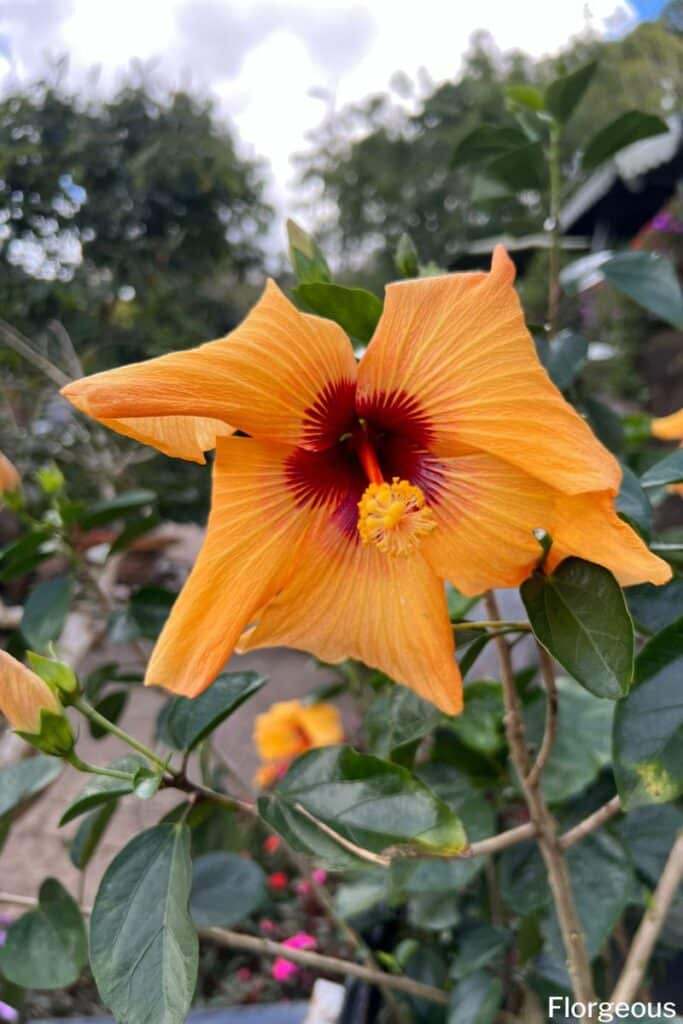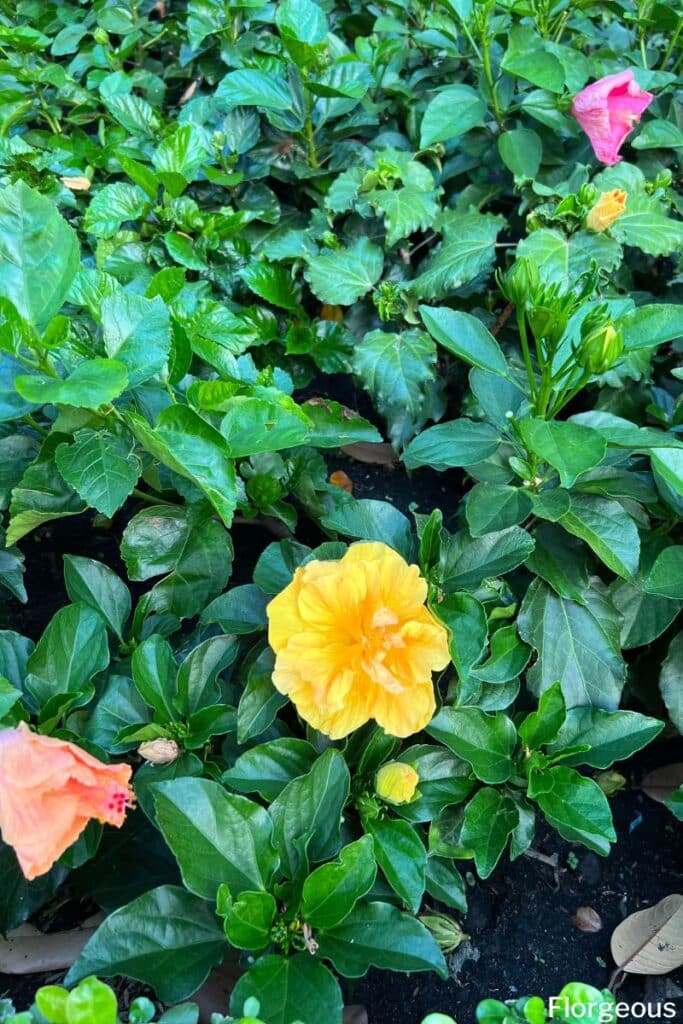Hibiscus is a beautiful flower that is often used as an ornamental plant. It’s easy to care for, with its large, vibrant blooms adding a touch of color to any garden or landscape.
But how do you ensure that you have a healthy plant?
Let’s take a look at everything you need to know for tropical hibiscus care, from hibiscus propagation to how to care for hibiscus whether you’re growing hibiscus indoors or outside.
Hibiscus Plant Facts
| Scientific name | Hibiscus |
| Common names | Rose mallow, dinner plate hibiscus, clown hibiscus, rose of Sharon, althea, China Rose |
| Family | Malvaceae |
| Plant Type | Herb, shrub, tree |
| Height and Width | 8-16 ft tall, 5-10 ft wide outdoors |
| Origin | Mauritius, Madagascar, Hawaii, China, India, Fiji |
| Flower colors | Red, Yellow, Orange, Pink, Multicolor, Purple, White |
| Foliage color | Dark green |
| Sun Exposure | Full sun |
| Soil Type & pH | Well-drained soil, slightly acidic soil |
| Special features | Beautiful flowers, good pollinator plant, attractive plant indoors or outside |

How to Grow Hibiscus Plants
Most hibiscus flowers can be planted in either pots or beds. When you plant hibiscus, think carefully about the hibiscus types you’re growing (hardy hibiscus can grow well outside in many places, but truly tropical hibiscus will perform best in a pot in most of the US).
When planting in a pot, make sure the pot is large enough so that the root system can spread out easily – generally, 6-8 inches wide is a good size for most hibiscus plants. Be sure to fill the pot with well-draining soil as hibiscus do not like wet feet! If planting in a garden bed, be sure to choose an area with plenty of sunlight — six hours per day or more.
When planting directly into the ground, dig a hole twice as big as your plant’s roots and mix compost or aged manure into the soil before planting.
Propagation
There are two main methods for propagating hibiscus plants to get even more of these exotic flowers — through stem cuttings or by air layering.
For stem cuttings, take approximately 4-6 inch cuttings from your existing plant and remove all leaves from the bottom half of each cutting. Place each cutting into moist soil until new growth appears (this usually takes 1-2 weeks).
To propagate through air layering, select an upright stem on your existing plant and score it lightly with a knife before wrapping it tightly with moist sphagnum moss.
After several weeks new roots should form on the moss at which point you can carefully cut below them and repot your new plant!
Soil
The ideal soil for hibiscus is rich in organic matter such as compost or aged manure; however regular potting soil will work just fine too!
Make sure that whatever type of soil you choose drains well so that your roots don’t become waterlogged and instead keep the soil evenly moist.
Pruning
Pruning is important for keeping your hibiscus healthy and full of flowers! In general, prune younger plants lightly throughout their growing season while more mature plants should be pruned more heavily during winter months (i.e., removing old flower heads).
Repotting and Transplanting
Mature hibiscus plants may require repotting every few years due to root overcrowding.
If this becomes necessary, make sure that you select a pot roughly one size larger than its current container with drainage holes at its base before gently transferring your plant into its new home.

How to Care for Hibiscus Tree
Let’s look at these important hibiscus plant care tips. Keep this in mind when selecting hibiscus companion plants with similar growing conditions.
Water
Your hibiscus flower will need water 1-2 times a week during the growing season (spring through fall).
During colder months when the plant is dormant, you can reduce the frequency of watering to once every two weeks or so. Make sure that when you water your perennial hibiscus, you give it enough water to thoroughly moisten its soil; be sure not to overwater as this can cause root rot.
Sunlight
Most hibiscus varieties need plenty of direct sunlight in order to thrive! Ideally, place it in a spot where it will get about 6-8 hours of direct sunlight each day.
If possible, move the pot outdoors during warmer months for maximum sun exposure. Position away from drafts and air conditioning vents as these can dry out the plant too quickly.
Temperature and Humidity
Hibiscus plants thrive in temperatures between 65°F and 85°F (18°C – 29°C). If the temperature drops below 60°F (15°C), then you might start seeing some signs of stress on your plant such as wilting or browning of leaves.
These tropical plants prefer high humidity levels—ideally around 70%. This means that they do well in hot climates where there is plenty of moisture in the air.
Fertilizer
When selecting a fertilizer for your hibiscus plants, look for one with an N-K ratio of 1:1 or 2:1. You should also look for a slow-release or low-burn formula; this will prevent any potential overwatering issues from occurring.
Typically, it’s best to feed your garden hibiscus once every two weeks during its active growth period—which typically occurs between spring and fall in North America—and once every month during its dormant period in winter months.
Pest and diseases
An important aspect of hibiscus care is dealing with pests. The most common pests of hibiscus plants include aphids, mealybugs, whiteflies, spider mites, thrips, scales, leafhoppers, caterpillars, borers, and Japanese beetles. All of these pests feed on the sap from the plant’s leaves and stems, which can cause damage in the form of yellowing leaves or wilting growth.
The most common diseases affecting tropical hibiscus plants include powdery mildew and verticillium wilt. Powdery mildew appears as a white powdery substance on the leaves or stems of the plant, while verticillium wilt causes yellowing leaves or wilting growth (similar symptoms as pest damage).
Hibiscus Cultivars
Hibiscus cultivars encompass a diverse array of stunning flowering plants renowned for their vibrant blooms and ornamental appeal. These cultivars, developed through selective breeding and hybridization, offer a wide range of colors, sizes, and forms, catering to various preferences and garden designs.
Popular hibiscus cultivars include the tropical Hibiscus rosa sinensis, known for its large, showy flowers in hues of red, pink, orange, yellow, and white. Varieties like ‘Red Dragon’ and ‘Cooperi’ showcase bold, intense colors, while ‘Snow Queen’ and ‘White Wings’ boast elegant white blooms. Double-flowered forms like ‘Double Peach’ and ‘Double Pink’ feature extra layers of petals, creating a lush, luxurious appearance.
Hardy hibiscus cultivars, such as Hibiscus syriacus or Rose of Sharon, are prized for their cold tolerance and profusion of blossoms. ‘Diana’ displays pure white flowers, while ‘Aphrodite’ dazzles with magenta blooms adorned with a contrasting red eye.
Other notable cultivars include Hibiscus mutabilis, with its color-changing flowers, and Hibiscus acetosella ‘Red Shield,’ esteemed for its striking burgundy foliage.
Conclusion
Growing and caring for hibiscus isn’t difficult — all you need is some patience and some basic knowledge on how to properly care for these colorful blooms. Don’t forget to learn more about the meaning of a hibiscus flower to know why gardeners love growing this plant.
FAQs
How do you keep hibiscus blooming?
To keep hibiscus blooming, provide them with adequate sunlight (at least 6 hours of direct sunlight per day), regular watering (allow the soil to dry out slightly between waterings), and fertilize them monthly during the growing season with a balanced fertilizer formulated for flowering plants.
How long do potted hibiscus last?
Potted hibiscus can last for several years if well cared for. With proper maintenance and environmental conditions, they can thrive and continue blooming for many seasons.
What triggers hibiscus to bloom?
Hibiscus are triggered to bloom by several factors, including exposure to long days (short nights) and warm temperatures. Additionally, proper care practices such as regular pruning, fertilizing, and watering can encourage blooming.
Why do hibiscus flowers fall off so quickly?
Hibiscus flowers may fall off quickly due to various reasons, including environmental stressors like extreme temperatures or sudden changes in light or water levels, pests or diseases, or improper care such as insufficient watering or fertilization.







